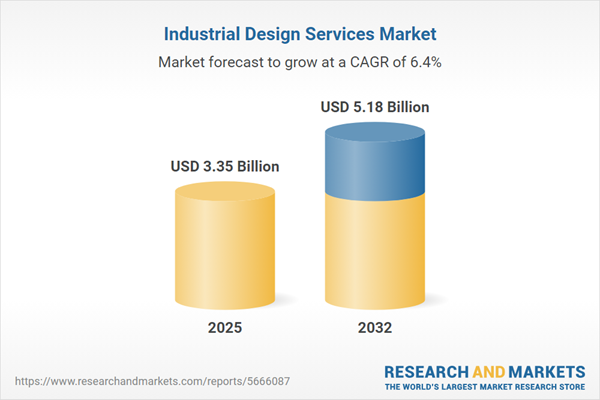Speak directly to the analyst to clarify any post sales queries you may have.
Industrial design services increasingly underpin organizations’ strategic objectives in dynamic global markets. As complexity grows, effective design solutions help enterprises balance compliance, competitiveness, and innovation, positioning leadership teams to achieve sustainable growth.
Market Snapshot: Industrial Design Services Market Insights
The global industrial design services market continues to demonstrate resilience, driven by executive-level investment in digital transformation, sustainability, and agile operations. These services have become essential across sectors such as manufacturing, healthcare, technology, and consumer goods, enabling organizations to innovate and maintain product relevance. Increasing focus on advanced design methods and strategic collaboration results in seamless digital integration, sharper stakeholder alignment, and sector-wide leadership advantages. Businesses also leverage industrial design support to adapt to changing regulatory environments and rising international competition.
Scope & Segmentation of the Industrial Design Services Market
Clear segmentation within the industrial design services market strengthens investment decisions, risk management, and operational excellence across diverse industries and regions. The following facets highlight the breadth of available services and technologies:
- Service Types: Concept development, detailed engineering, ergonomic optimization, aesthetic advancement, manufacturing support, and rapid prototyping all drive rapid product cycles and enable organizational agility.
- End User Industries: Aerospace, defense, automotive, healthcare, consumer electronics, and industrial machinery require customized approaches due to unique compliance standards and technical requirements.
- Technology: Integration of 3D printing, computer-aided design, simulation, augmented reality, and virtual reality enhances project accuracy and facilitates collaboration for distributed global teams.
- Delivery Modes: Hybrid, onsite, and remote service approaches align with varied project cultures and logistics, ensuring responsiveness and flexibility in execution.
- Engagement Models: Dedicated teams, project-based tasks, and time-and-materials contracts provide adaptable options to support risk assessment and tailored investment strategies.
- Firm Sizes: Providers cater to global enterprises and small or mid-sized organizations, combining broad reach with targeted market insights.
- Pricing Models: Fixed-price, hourly, and outcome-based billing support transparent, accountable project management and budgeting practices.
- Applications: Maintenance, system upgrades, packaging innovation, new product introductions, and UX/UI improvements drive value at every stage of the product lifecycle.
- Regions: Americas, Europe, Middle East & Africa, and Asia-Pacific exhibit varied economic, regulatory, and operational conditions, influencing service delivery and market approach.
Key Takeaways for Industrial Design Leaders
- Automating digital workflows increases operational efficiency and enhances visibility for multifaceted and multi-phase projects.
- Integrating sustainable design measures fortifies compliance and cultivates broader stakeholder trust in both local and international markets.
- Application of artificial intelligence and digital collaboration solutions improves productivity while enabling real-time cooperation across geographic boundaries.
- Ongoing technical upskilling and focus on user-centric design prepare teams to adapt to evolving client demands and industry trends.
- Choice of flexible engagement and adaptive service delivery enables organizations to respond effectively to changing regulatory or market dynamics, strengthening long-term client relationships.
Tariff Impact on Industrial Design Service Supply Chains
Recent U.S. tariff policies have increased complexity and costs within industrial design service supply chains. Organizations now collaborate more actively with regional providers and bolster local production, reassessing existing supply networks. While these measures may change cost structures, they help ensure project continuity and stability amid global uncertainty.
Methodology & Data Sources
This analysis integrates executive interviews, sector-specific surveys, and leading market data, applying triangulation and peer review for validation. Executive teams benefit from actionable, relevant insights that support informed strategies.
Why This Report Matters: Industrial Design Services
- Empowers leadership to deploy advanced tools, anticipate market shifts, and address region-specific operational challenges.
- Delivers performance benchmarks and supports agile team development in an environment of continuous transformation.
- Enables informed risk mitigation and proactive compliance management amid escalating industry complexity.
Conclusion
Adaptive industrial design services help organizations enhance strategic agility and sustain competitive relevance. Through flexible models and robust planning, leaders are equipped to respond confidently as market environments evolve.
Additional Product Information:
- Purchase of this report includes 1 year online access with quarterly updates.
- This report can be updated on request. Please contact our Customer Experience team using the Ask a Question widget on our website.
Table of Contents
3. Executive Summary
4. Market Overview
7. Cumulative Impact of Artificial Intelligence 2025
Companies Mentioned
The companies profiled in this Industrial Design Services market report include:- IDEO LLC
- Frog Design Inc.
- EPAM Continuum
- fuseproject, LLC
- RKS Design Ltd
- Smart Design LLC
- Cambridge Design Partnership Ltd
- Ziba Design LLC
- Pentagram LLP
- Astro Studios LLC
Table Information
| Report Attribute | Details |
|---|---|
| No. of Pages | 188 |
| Published | October 2025 |
| Forecast Period | 2025 - 2032 |
| Estimated Market Value ( USD | $ 3.35 Billion |
| Forecasted Market Value ( USD | $ 5.18 Billion |
| Compound Annual Growth Rate | 6.3% |
| Regions Covered | Global |
| No. of Companies Mentioned | 11 |









